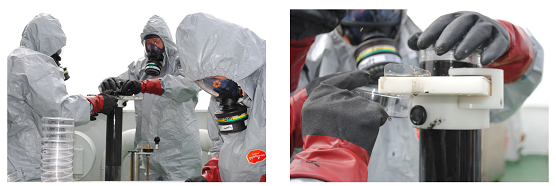Chemical weapons were produced and used in a large scale during the World Wars. According to official records, at least 50,000 tonnes of chemical warfare agents (CWA) contained in bombs, shells and other warfare materials were afterwards dumped in the Baltic Sea, and ca. 170,000 tonnes in the adjacent Skagerrak Strait.

© Photos: Kari Lehtonen
Investigating the current condition of the sea-dumped CWA is important due to the ever-growing use of the sea floor for marine constructions such as offshore wind farms, underwater oil and gas pipelines and cables. After several decades in the sea, a large part of the dumped materials currently is in an advanced state of corrosion and the CWA now leaking out pose a serious threat to the marine ecosystem. Leaking of the substances to the marine environment has been shown in analyses of sediment samples collected from areas close to known CWA dumping areas. The investigations have thus far focused on CWAs leaking from the ammunition, such as phenylarsenic compounds and sulfur mustard and their primary degradation products. However, to assess their total environmental burden and risk to the marine ecosystem reliably it is necessary to identify also other degradation products and their toxic properties.
The WARTOX project (2021-2023) funded by the Academy of Finland focuses on the CWA degradation products generated by microbial activity in Baltic Sea sediments, and their bioaccumulation and toxicity for aquatic organisms. New biotransformation products in observed in sediments and aquatic organisms and sediments will be characterized by applying structure elucidation methods. Degradation mechanisms in cellular metabolism of organisms and the toxicity of the degradation products are examined using cell cultures and biotest organisms.
In addition to new scientific results, the outcome of the project will be disseminated to decision makers and authorities who are through international networks dealing with decision-making concerning the management of sea-dumped munitions. WARTOX generates important information also for the monitoring of sea-dumped CWA, which has been emphasized already in previous international research projects. In addition, public awareness of problems related to sea-dumped CWA will be increased.

© Photo: The Finnish Defence Forces
More information:
Groupmanager Kari Lehtonen
Finnish Environment Institute Syke
Marine and freshwater solutions, Pollution effects
firstname.surname@syke.fi
Tel: +358 295 251 359